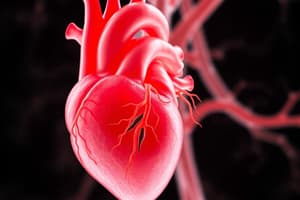Podcast
Questions and Answers
What are the common causes of cardiac valve stenosis and incompetence?
What are the common causes of cardiac valve stenosis and incompetence?
Cusp damage, Rheumatic heart disease, Floppy valve & Marfan syndrome, Infective endocarditis, Chordae, Papillary muscle, Valve ring, age
Define infective endocarditis.
Define infective endocarditis.
Infection of valve with formation of thrombotic vegetations
What are some risk factors for infective endocarditis?
What are some risk factors for infective endocarditis?
Valve damage, Bacteraemia, Dental, Catheterisation, iv drug abuse, Immunosuppression
Describe the composition of a vegetation.
Describe the composition of a vegetation.
Describe the principles of diagnosis, treatment and prevention of infective endocarditis.
Describe the principles of diagnosis, treatment and prevention of infective endocarditis.
Define the terms stenosis and incompetence.
Define the terms stenosis and incompetence.
What are the common causes of cardiac valve stenosis and incompetence?
What are the common causes of cardiac valve stenosis and incompetence?
What is infective endocarditis?
What is infective endocarditis?
What are some risk factors for infective endocarditis?
What are some risk factors for infective endocarditis?
What are the principles of diagnosis, treatment, and prevention of infective endocarditis?
What are the principles of diagnosis, treatment, and prevention of infective endocarditis?
Which artery determines the coronary dominance in approximately 80% of people?
Which artery determines the coronary dominance in approximately 80% of people?
What are the branches of the Left Coronary artery?
What are the branches of the Left Coronary artery?
What is the function of the Sinu-atrial node (SA node)?
What is the function of the Sinu-atrial node (SA node)?
Describe the origin, course and distribution of the coronary arteries.
Describe the origin, course and distribution of the coronary arteries.
Explain the importance of the anastomoses between the coronary arteries.
Explain the importance of the anastomoses between the coronary arteries.
Describe the anatomical position of the conducting system of the heart and how it controls heart rate.
Describe the anatomical position of the conducting system of the heart and how it controls heart rate.
What are the components of the cardiac conduction system?
What are the components of the cardiac conduction system?
How is the right bundle branch located in the heart?
How is the right bundle branch located in the heart?
Where does the left bundle branch descend in the heart?
Where does the left bundle branch descend in the heart?
What are the nerve supply to the heart and their functions?
What are the nerve supply to the heart and their functions?
What is the embryological cause of atrial septal defect (ASD)?
What is the embryological cause of atrial septal defect (ASD)?
What is the embryological cause of ventricular septal defect (VSD)?
What is the embryological cause of ventricular septal defect (VSD)?
What is the embryological cause of Tetralogy of Fallot?
What is the embryological cause of Tetralogy of Fallot?
What is the embryological cause of transposition of the great vessels?
What is the embryological cause of transposition of the great vessels?
What is the embryological cause of coarctation of the aorta?
What is the embryological cause of coarctation of the aorta?
What is the embryological cause of the extension between pulmonary trunk and aorta?
What is the embryological cause of the extension between pulmonary trunk and aorta?
What are some possible causes of the development of the extension between pulmonary trunk and aorta?
What are some possible causes of the development of the extension between pulmonary trunk and aorta?
What is the composition of the IA septum?
What is the composition of the IA septum?
What is the cause of excessive resorption of septum primum?
What is the cause of excessive resorption of septum primum?
What are some congenital conditions associated with the embryological development of the heart?
What are some congenital conditions associated with the embryological development of the heart?
Flashcards are hidden until you start studying




